Soundlab Audiophile G9-7c: a 30-year odyssey fulfilled
- Thread starter godofwealth
- Start date
You are using an out of date browser. It may not display this or other websites correctly.
You should upgrade or use an alternative browser.
You should upgrade or use an alternative browser.
Point well-taken, but you’re reading my blog incorrectly if you think it’s all about the SL’s. It’s about the entire system, including the ARC 750SE’s, the ARC 6SE and the Lampizator DAC etc. A system is only as good as the weakest link. For most people I think that’s the loudspeakers. Most folks don’t have the space or funds for a 9’ pair of humongous electrostatics, or perhaps to keep domestic harmony, they can’t buy them. I expect most folks wouldn’t like my SL’s because they’re not audiophile loudspeakers. They’re loudspeakers for music lovers. They don’t do boom boom or have a sizzle on top like the big box loudspeakers. They won’t play loud enough to scare all the cats in your neighborhood. I could write a long blog about how bad SL’s are as audiophile loudspeakers. But I hate audiophile loudspeakers. I’ve owned a lot of those. The SL’s are a music lovers speaker. Kind of like the ESL-57s. What they do is incomparable. But they don’t do it all. You have to decide what sort of sound you like or what sort of coloration. I would argue 99% of audiophiles like the boom boom sound. SL’s are not the loudspeakers for them.
It might be more accurate and objective to suggest that SL's are good speakers for the type of music you love. If your musical tastes were more wide ranging my guess is you wouldn't like them as well. It is absurdly demeaning to suggest people that love music you dislike aren't in fact music lovers. I read your posts because you love music that I would never think to listen to. Most if it I don't like but there are enough great nuggets in the albums you share that I do keep coming back.Point well-taken, but you’re reading my blog incorrectly if you think it’s all about the SL’s. It’s about the entire system, including the ARC 750SE’s, the ARC 6SE and the Lampizator DAC etc. A system is only as good as the weakest link. For most people I think that’s the loudspeakers. Most folks don’t have the space or funds for a 9’ pair of humongous electrostatics, or perhaps to keep domestic harmony, they can’t buy them. I expect most folks wouldn’t like my SL’s because they’re not audiophile loudspeakers. They’re loudspeakers for music lovers. They don’t do boom boom or have a sizzle on top like the big box loudspeakers. They won’t play loud enough to scare all the cats in your neighborhood. I could write a long blog about how bad SL’s are as audiophile loudspeakers. But I hate audiophile loudspeakers. I’ve owned a lot of those. The SL’s are a music lovers speaker. Kind of like the ESL-57s. What they do is incomparable. But they don’t do it all. You have to decide what sort of sound you like or what sort of coloration. I would argue 99% of audiophiles like the boom boom sound. SL’s are not the loudspeakers for them.
I think it's fair to state that electrostatics in general are great for listening to music that is recorded in a natural ambience, such as a jazz club, a chamber music hall, a church, or a concert hall. When you get into hard rock and roll that is mixed in a studio with electronic sound effects, then what you hear with an electrostatic might not be what you like. As Peter Walker once said, electrostatics are all about ``documentary sound reproduction". They reproduce more accurately than most loudspeakers what is fed into them. But for hard rock and roll, you might not like what you hear. They'll reveal, in a gentle way with the large SL's, all the problems with the miking. As Walker said once, the "images stick out like sore thumbs". So, at the end of the day, it comes down to personal preferences, like all things in high end audio. You like what you like. There is no point in getting something or hearing something you don't like. Life's too short! I've owned a lot of loudspeakers over the past 40 years, and let's just say there are some that I'll never go back to owning. Also my listening preferences have changed. I am far more of a music lover than a hard-core audiophile. Meaning, I don't sit with my butt glued to the listening chair in the middle and look for a certain type of soundstaging or imaging. I used to do that 30+ years ago, when I read too much of The Absolute Sound. But, as you grow older, you get wiser (eventually!).
I think it's fair to state that electrostatics in general are great for listening to music that is recorded in a natural ambience, such as a jazz club, a chamber music hall, a church, or a concert hall. When you get into hard rock and roll that is mixed in a studio with electronic sound effects, then what you hear with an electrostatic might not be what you like. As Peter Walker once said, electrostatics are all about ``documentary sound reproduction". They reproduce more accurately than most loudspeakers what is fed into them. But for hard rock and roll, you might not like what you hear. They'll reveal, in a gentle way with the large SL's, all the problems with the miking. As Walker said once, the "images stick out like sore thumbs". So, at the end of the day, it comes down to personal preferences, like all things in high end audio. You like what you like. There is no point in getting something or hearing something you don't like. Life's too short! I've owned a lot of loudspeakers over the past 40 years, and let's just say there are some that I'll never go back to owning. Also my listening preferences have changed. I am far more of a music lover than a hard-core audiophile. Meaning, I don't sit with my butt glued to the listening chair in the middle and look for a certain type of soundstaging or imaging. I used to do that 30+ years ago, when I read too much of The Absolute Sound. But, as you grow older, you get wiser (eventually!).
What a beautifully constructed & presented response - not dissimilar to how you have presented the albums in this thread - outstanding...
Had four different stats and the MBL 116's over some 3 decades when I was into that sort of thing. Mainly classical and jazz on the menu but I was not remiss when I played other music types as well. But I do agree with your thoughts on ESL sound. Thanks again for your musical summaries.
Today I’m listening to my Quad 2905s driven by solid state Mola Mola electronics: the all-in-one MAKUA preamp with the internal Tambaqui DAC and the Kaluga 400 watt class D monoblocks. The sound is quite different from my SL’s for several reasons, including the design of the Quads, the long narrow dining room where I have my Quads, and of course the solid state electronics. The tonality is brighter, crisper and more vivid. We are listening to a recording by the famous Hesperion ensemble led by the inimitable Jordi Savall. The man is a legend. He takes a particular theme and does incredible research on it. His liner notes are like doctoral dissertations, hundreds of pages long. We are listening to music from the 16th to the 18th century around the theme of Folia, a kind of melody that originated in Portugal in the 15th century and is considered the origin of melody in Europe. Not surprisingly Jordi Savall explores every conceivable variation across several centuries in this 70+ minute album. Here’s a simple example of a Folia.
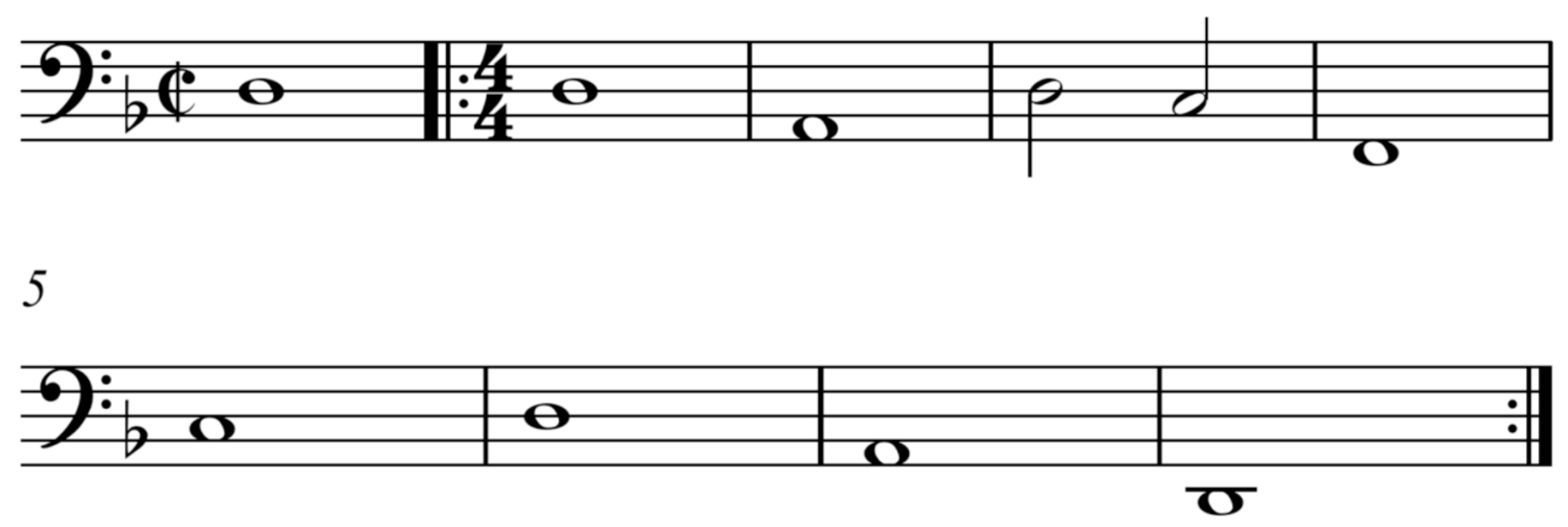
More than 150 composers over 300 years used the Folia melodic structure in their compositions, so addictive it was. The list includes Vivaldi, Corelli, Geminiani, Lully, Scarlatti, Handel, Bach, Purcell, Cherubini, Salieri, Liszt, Beethoven, etc. A Folia was a style of composition, like a particular sequence of chords in jazz. Composers got addicted to it and it took off. This is typical of what makes a Jordi Savall album great. He doesn’t just play music. He wants to educate you. You listen to one of his albums, read through his exhaustive liner notes, and you feel like you’ve earned a degree in musicology.
He often visits the nearby campus of U.C. Berkeley. Many years ago, I visited Barcelona to attend a scientific meeting. I missed a concert by him by a day. Boy, was I unhappy! This recording is Redbook, which I’m streaming. Savall generally releases all his albums on SACDs with a huge handbook of his liner notes aka Savall dissertation. I picked up a few in Barcelona and struggled home with the huge package of his tomes. This recording is on original instruments. It’s a sharp-edged sound, incisive and vivid. It’s got a jumpy sound, full of dynamic climaxes. You won’t fall asleep hearing it. It’s not a pretty sound, but in the Renaissance, they liked their instruments to sound a bit ragged. It’s not a Stradivarius type of smooth sound. Of course, seventy minutes of Folia can be a bit exhausting. Best consumed in smaller doses.
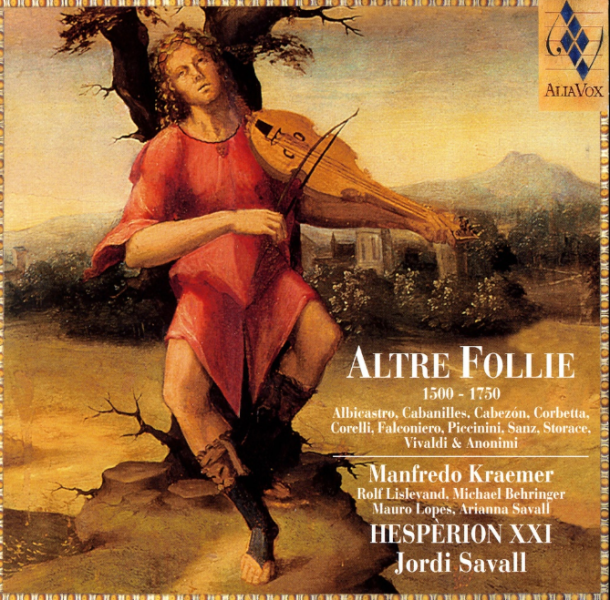

More than 150 composers over 300 years used the Folia melodic structure in their compositions, so addictive it was. The list includes Vivaldi, Corelli, Geminiani, Lully, Scarlatti, Handel, Bach, Purcell, Cherubini, Salieri, Liszt, Beethoven, etc. A Folia was a style of composition, like a particular sequence of chords in jazz. Composers got addicted to it and it took off. This is typical of what makes a Jordi Savall album great. He doesn’t just play music. He wants to educate you. You listen to one of his albums, read through his exhaustive liner notes, and you feel like you’ve earned a degree in musicology.
He often visits the nearby campus of U.C. Berkeley. Many years ago, I visited Barcelona to attend a scientific meeting. I missed a concert by him by a day. Boy, was I unhappy! This recording is Redbook, which I’m streaming. Savall generally releases all his albums on SACDs with a huge handbook of his liner notes aka Savall dissertation. I picked up a few in Barcelona and struggled home with the huge package of his tomes. This recording is on original instruments. It’s a sharp-edged sound, incisive and vivid. It’s got a jumpy sound, full of dynamic climaxes. You won’t fall asleep hearing it. It’s not a pretty sound, but in the Renaissance, they liked their instruments to sound a bit ragged. It’s not a Stradivarius type of smooth sound. Of course, seventy minutes of Folia can be a bit exhausting. Best consumed in smaller doses.

Science Fiction movies are always centered around the possibility of time travel. Imagine traveling into the future or the past to find out some information that you desperately wanted to know. Of course, scientists are often interested in questions about their particular areas of research. In pure mathematics the greatest unsolved problem has to do with a particular function called the Riemann zeta function. The conjecture is that all its solutions lie on a certain axis on the complex plane, a 2-dimensional plane essentially. Here is the original paper by Riemann published in 1859.
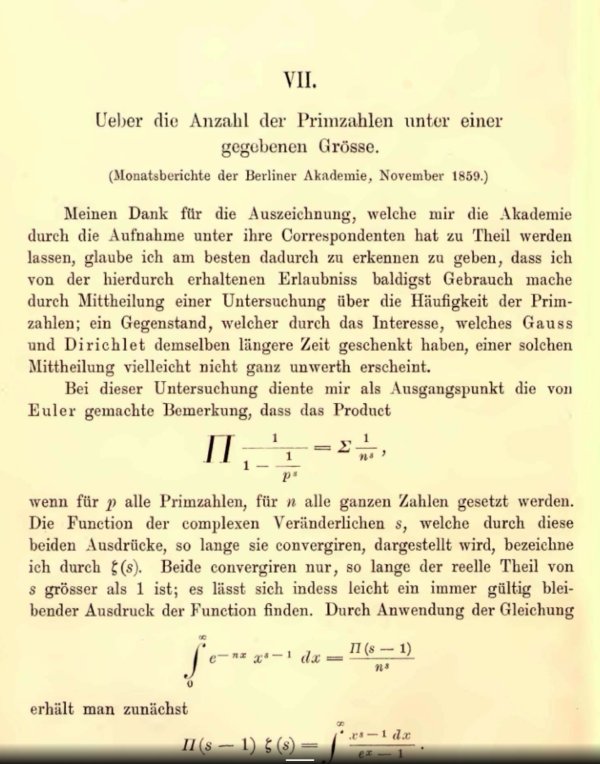
Now, you’re probably thinking what in the world is wrong with these folks. Why does this matter? Well, two centuries of research has shown that this pesky function is everywhere. In particular it is closely related to the distribution of prime numbers. Ok, you forgot high school math. A prime number is any number only divisible by 1 and itself. So, a standard programming exercise is to efficiently generate all prime numbers. Of course it starts with 1. 2 is also prime, the only even prime number. Then we have 3. 4 is divisible by 2, so we skip it. 5 is prime. We skip 6. 7 is prime. 8 is not prime. 9 is not. 10 is not. 11 is prime. 12 is not. 13 is prime. 14, 15,16 are not. 17 is prime. And so on. What’s the pattern? If you figure that out, it’s worth billions of dollars! Why?
Well, every time you buy something online, there’s a cryptography protocol that hides your transaction by applying a code so eavesdropping your financial data is not easy. The secrecy protocol is generated using prime numbers. If you can factor a number efficiently using prime numbers, you can crack a lot of secrets. Well, no one has yet figured out the pattern of prime numbers. We know the general distribution, roughly how many there are between two numbers, and a lot more, but no solution to the Riemann zeta function. A famous mathematician once said that when he finally got to meet God, he’d ask him first if the Riemann hypothesis was true.
Back to music. Time travel in music is easy. We can just listen to a recording of some very old music. I’m listening to Gothic music of the 12th and 13th century. Compared to the above Folia recording is interesting. In the 12th and 13th century, they hadn’t figured out what melody was. Like the ancients didn't know the planets revolved around the sun, not the other way around. We are listening to a great old recording by David Munro and the Early Music Consort of London. It’s eerie listening to this because it’s medieval pre-music. These guys hadn’t figured out how to create a tune. So, they hummed and hawed around a bunch of notes, but it just doesn’t click. They hadn’t yet figured out Folia. It’s like the mathematicians don’t know how primes are distributed. Perhaps in 2300 any kid will have a super cool thinking machine implant that can solve this or any other math problem. Word on the AI street is that some hush hush projects in big Bay Area companies are working on getting AI to solve the Riemann hypothesis. What would Riemann have thought of all this?
To me, music and math have been my constant companions for 40+ years. I got into AI reading a book on math, music, and art, and AI. It’s called Gödel, Escher, Bach: An eternal Golden Thread. It won the Pullitzer price for non-fiction. It’s 800 pages, but a mind-blowing book. Check it out!
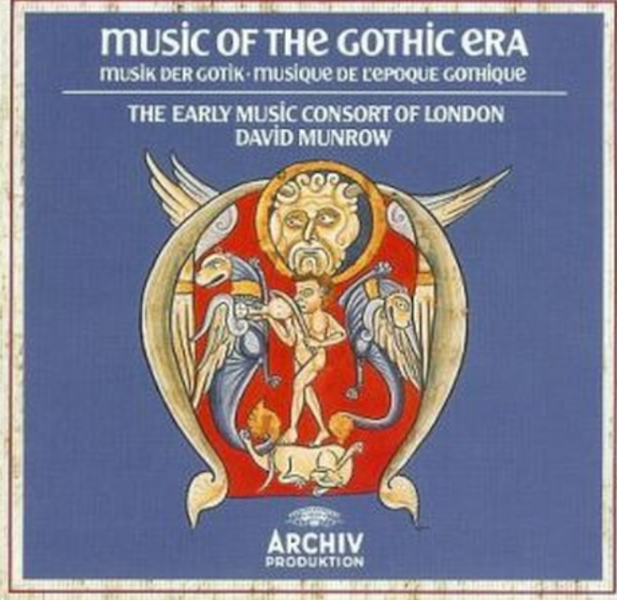

Now, you’re probably thinking what in the world is wrong with these folks. Why does this matter? Well, two centuries of research has shown that this pesky function is everywhere. In particular it is closely related to the distribution of prime numbers. Ok, you forgot high school math. A prime number is any number only divisible by 1 and itself. So, a standard programming exercise is to efficiently generate all prime numbers. Of course it starts with 1. 2 is also prime, the only even prime number. Then we have 3. 4 is divisible by 2, so we skip it. 5 is prime. We skip 6. 7 is prime. 8 is not prime. 9 is not. 10 is not. 11 is prime. 12 is not. 13 is prime. 14, 15,16 are not. 17 is prime. And so on. What’s the pattern? If you figure that out, it’s worth billions of dollars! Why?
Well, every time you buy something online, there’s a cryptography protocol that hides your transaction by applying a code so eavesdropping your financial data is not easy. The secrecy protocol is generated using prime numbers. If you can factor a number efficiently using prime numbers, you can crack a lot of secrets. Well, no one has yet figured out the pattern of prime numbers. We know the general distribution, roughly how many there are between two numbers, and a lot more, but no solution to the Riemann zeta function. A famous mathematician once said that when he finally got to meet God, he’d ask him first if the Riemann hypothesis was true.
Back to music. Time travel in music is easy. We can just listen to a recording of some very old music. I’m listening to Gothic music of the 12th and 13th century. Compared to the above Folia recording is interesting. In the 12th and 13th century, they hadn’t figured out what melody was. Like the ancients didn't know the planets revolved around the sun, not the other way around. We are listening to a great old recording by David Munro and the Early Music Consort of London. It’s eerie listening to this because it’s medieval pre-music. These guys hadn’t figured out how to create a tune. So, they hummed and hawed around a bunch of notes, but it just doesn’t click. They hadn’t yet figured out Folia. It’s like the mathematicians don’t know how primes are distributed. Perhaps in 2300 any kid will have a super cool thinking machine implant that can solve this or any other math problem. Word on the AI street is that some hush hush projects in big Bay Area companies are working on getting AI to solve the Riemann hypothesis. What would Riemann have thought of all this?
To me, music and math have been my constant companions for 40+ years. I got into AI reading a book on math, music, and art, and AI. It’s called Gödel, Escher, Bach: An eternal Golden Thread. It won the Pullitzer price for non-fiction. It’s 800 pages, but a mind-blowing book. Check it out!

Continuing our time travel adventure, we are now in France in the reign of King Louis XIII, who lived from 1601-1643. If you have visited Paris, you must have toured the famous Louvre Museum, the world’s most famous museum. Well, 400 years ago, this magnificent structure was the official residence of French kings. Not they didn’t have other palaces, like the Versailles. But in ooh la la Pari, they hung out at the Louvre. And every evening it was a place of dance, of music and gaiety. This wonderful recording gives us a taste of what musical life was in Paris 400 years ago for the ultra privileged who could attend the musical soirées of King Louis XIII. It’s a stark contrast to the Gothic era album by David Munro above. In the 12th century, they didn’t quite figure out how to make a tune. In the 16th century, they’d definitely made progress. No, it’s not Taylor Swift yet, but their music has a definite melodic rhythm, and they were getting the hang of it. Imagine if they could time travel and hear a Taylor Swift Eras concert. Then they could time travel back to tell Louis XIII all about this strange music from the 21st century.
This is a high-resolution recording from the legendary Harmonia Mundi label. I’m listening to my secondary system, all solid state, so I do miss the tube richness of my ARC and Lampi gear. But on this music, a bright sheen is probably what these guys were into. This is called the galant period in French history, when they’d figured out how to have a good time. The horrors of the French Revolution and the guillotine were still in the future.
Next time you visit the Louvre to see the famous Mona Lisa painting, which draws so many millions of tourists each year the French government decided to house it in its own gallery, imagine it as a place of music. Leonardo da Vinci who painted the Mona Lisa dragged the painting everywhere he went for decades. It’s a small painting. He would add a flourish, a dab here and there. And then put it aside. Now it’s the world’s most valuable painting, worth billions. A small painting, a few dabs of paint, centuries old, and the world’s most famous enigmatic smile. Worth billions. Makes you wonder….if time travel allowed to you visit da Vinci while he was painting it.
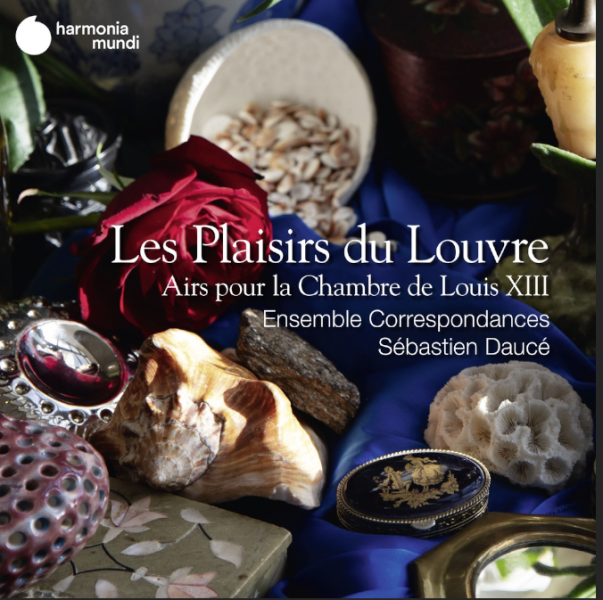
This is a high-resolution recording from the legendary Harmonia Mundi label. I’m listening to my secondary system, all solid state, so I do miss the tube richness of my ARC and Lampi gear. But on this music, a bright sheen is probably what these guys were into. This is called the galant period in French history, when they’d figured out how to have a good time. The horrors of the French Revolution and the guillotine were still in the future.
Next time you visit the Louvre to see the famous Mona Lisa painting, which draws so many millions of tourists each year the French government decided to house it in its own gallery, imagine it as a place of music. Leonardo da Vinci who painted the Mona Lisa dragged the painting everywhere he went for decades. It’s a small painting. He would add a flourish, a dab here and there. And then put it aside. Now it’s the world’s most valuable painting, worth billions. A small painting, a few dabs of paint, centuries old, and the world’s most famous enigmatic smile. Worth billions. Makes you wonder….if time travel allowed to you visit da Vinci while he was painting it.

In the tradition of chamber music, the piano quintet has a special place in a composer’s heart. All the great composers, from Brahms to Dvorak to Faure to Mozart wrote piano quintets or piano quartets. Adding a piano to strings gave you melody and percussion. Like jazz quartets always have a drummer, classical musicians like to have a piano to get some percussion into a piece. A piano is like a drum: it produces sound by little hammers striking. Beethoven wrote a famous piano sonata called Hammerklavier (literally meaning a piano that’s a hammer).
We are listening to virtually unknown Polish composers in a wonderful Hyperion high resolution 24-bit 96khz recording featuring Friedman and Rozycki piano quintets. They are very Brahmsian: richly melodic and in the grand romantic tradition that earmarked the 19th century of classical music before the like of Stravinsky and Schoenberg changed classical music in the 20th century. In their pieces, melody is still cherished. In the 20th century, classical music got atonal. Melody was frowned upon. If you wrote melodies you were looked down upon. I recall hearing Christoph Penderecki’s cello concerto — another Polish composer — being played in a live concert by the San Francisco Symphony. It was a freak horror show. Lots of squealing sounds by the cello and angry outbursts from the orchestra. It sounded like they were having a fight, nit making music. The audience cheered. I was dumbfounded that this could be called music.
Here we are very much in the Romantic tradition of Brahms, Schumann (another composer who wrote a lovely piano quintet), and Dvorak, and thankfully not in the bizarre world of Pendetecki. The sound is gorgeous on the big SL’s, helped by a generous dose of tube richness from the ARC and Lampi electronics. Both pieces were written in the 20th century around the time of World War I (1913 and 1918). Albert Einstein had just published his revolutionary theory of General Relativity that showed that gravity was because space itself was bent by matter, a theory that has held up to every test thrown at it for over 100 years. When you throw a baseball and it curves in space, it’s actually going in a straight line because the earth is curving space near it.
Music is always at the core of many scientist’s hearts because of its deeply mathematical structure. Einstein loved playing his violin. He did like his vinyl records. There’s a deep connection between music and math. Bach’s fugues are mathematical objects. Here we are enjoying two beautiful piano quintets that need to be heard by a wider audience. Piano gives it rhythm and strings the melody. Like space and time. Each needs the other. Einstein unified space and time, but not quantum theory and gravity. That’s the hardest problem in physics now. Black holes cone out of Einstein’s theory but he hated the idea. As physicists like to joke, who ordered that? The universe is what it is. You have to enjoy it, black holes and all.
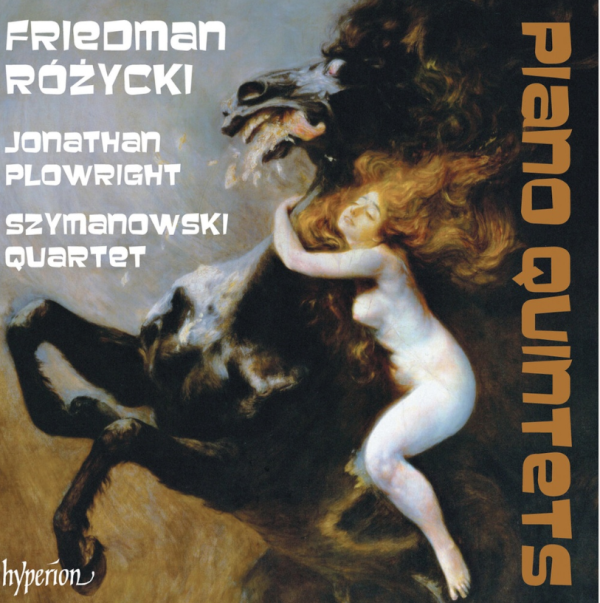
We are listening to virtually unknown Polish composers in a wonderful Hyperion high resolution 24-bit 96khz recording featuring Friedman and Rozycki piano quintets. They are very Brahmsian: richly melodic and in the grand romantic tradition that earmarked the 19th century of classical music before the like of Stravinsky and Schoenberg changed classical music in the 20th century. In their pieces, melody is still cherished. In the 20th century, classical music got atonal. Melody was frowned upon. If you wrote melodies you were looked down upon. I recall hearing Christoph Penderecki’s cello concerto — another Polish composer — being played in a live concert by the San Francisco Symphony. It was a freak horror show. Lots of squealing sounds by the cello and angry outbursts from the orchestra. It sounded like they were having a fight, nit making music. The audience cheered. I was dumbfounded that this could be called music.
Here we are very much in the Romantic tradition of Brahms, Schumann (another composer who wrote a lovely piano quintet), and Dvorak, and thankfully not in the bizarre world of Pendetecki. The sound is gorgeous on the big SL’s, helped by a generous dose of tube richness from the ARC and Lampi electronics. Both pieces were written in the 20th century around the time of World War I (1913 and 1918). Albert Einstein had just published his revolutionary theory of General Relativity that showed that gravity was because space itself was bent by matter, a theory that has held up to every test thrown at it for over 100 years. When you throw a baseball and it curves in space, it’s actually going in a straight line because the earth is curving space near it.
Music is always at the core of many scientist’s hearts because of its deeply mathematical structure. Einstein loved playing his violin. He did like his vinyl records. There’s a deep connection between music and math. Bach’s fugues are mathematical objects. Here we are enjoying two beautiful piano quintets that need to be heard by a wider audience. Piano gives it rhythm and strings the melody. Like space and time. Each needs the other. Einstein unified space and time, but not quantum theory and gravity. That’s the hardest problem in physics now. Black holes cone out of Einstein’s theory but he hated the idea. As physicists like to joke, who ordered that? The universe is what it is. You have to enjoy it, black holes and all.

Last edited:
And now we hear one of classical music’s most loved composers, the Czech composer Antonin Dvorak with one of his most famous compositions, his Piano Quintet. The recording is by classical music’s royalty: the legendary Emerson Quartet with piano superstar Evgeny Kissin. Even better, it’s a live recording at New York City’s most famous concert hall, Carnegie Hall made in 2018. Even though it has the dreaded yellow label (Harry Pearson didn’t include a single DG recording in his Super Disc list), DG has made many fine recordings. As they say, don’t judge an album by its cover. This high resolution recording delivers the goods in spades. It’s gorgeous tonally and the music is divine. The performance is of course nonpareil. These guys are superstars, so they play in ways mere great musicians can only dream of. Dvorak wrote profound music, full of beauty, and his Piano Quintet is one of his greatest works. You haven’t lived if you haven’t heard this piece. I have it on vinyl too, a rare double album by DG. Confession: the vinyl sounds “better” on my SME 20/12 with a Koetsu Onyx Platinum cartridge. But here I’m listening to the 24-bit 96khz streaming version. Boy, does it sound gorgeous. A desert island disc. Wish I could have heard the live performance. I’d have paid a lot of money to be there.
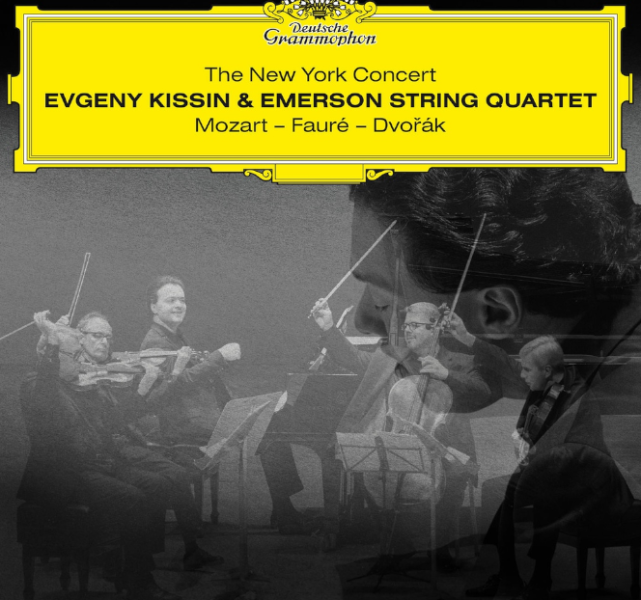

Listening to my La Scala horns today driven by a flea sized 1-watt pair of Triode Labs SET monoblocks with RCA 45 tubes, a Western Electric 422a rectifier — the rarest variant of the 274b — and a Tekefunken smooth plate 12AX7. The sound is smooth and in classic SET fashion with heaps of tube richness. The preamp is a CJ Gat Series II and the digital source is an Eversolo DMP-A8 server-DAC.
We are listening to a Mosaic Records box set of previously unissued live recordings of Paul Desmond in Toronto. His sax playing has been called as smooth as a dry martini. The sound is of course very different from the 9-foot SL electrostatic loudspeakers. Horns project a more concentrated beam of sound because the deep 24” depth of the La Scalas, which gives it a 105dB efficiency, colors the sound in a certain way that’s very different from an open panel. It’s still a very musical sound but the presentation is very different. It’s amazing to drive a loudspeaker with a 1 watt amplifier using a single triode power tube, instead of 18 KT-150s on my giant ARC 750SE behemoths. Needless to say, the little SETs produce less heat than many solid state amplifiers.
The recording is quite nice and Desmond plays his usual cool and unemotional style. It’s a little bland compared to John Coltrane or Charlie Mingus. Very buttoned down jazz, sort of schmaltzy. But perfect for an evening of relaxation with some fine Petite Syrah wine from my local winery a mile from my house.
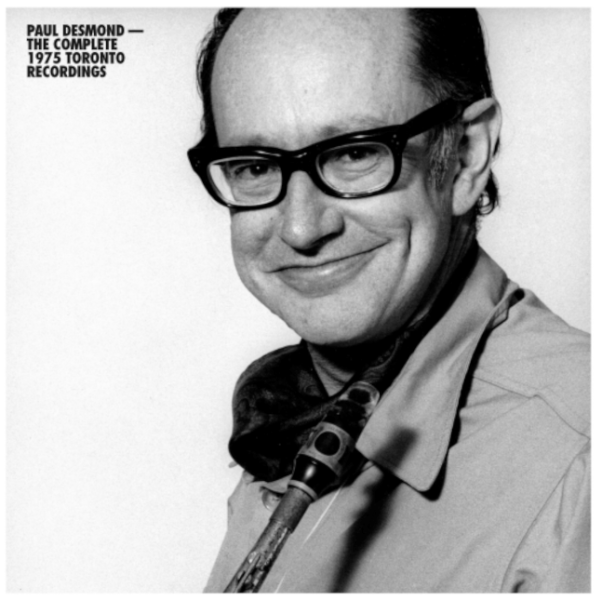
We are listening to a Mosaic Records box set of previously unissued live recordings of Paul Desmond in Toronto. His sax playing has been called as smooth as a dry martini. The sound is of course very different from the 9-foot SL electrostatic loudspeakers. Horns project a more concentrated beam of sound because the deep 24” depth of the La Scalas, which gives it a 105dB efficiency, colors the sound in a certain way that’s very different from an open panel. It’s still a very musical sound but the presentation is very different. It’s amazing to drive a loudspeaker with a 1 watt amplifier using a single triode power tube, instead of 18 KT-150s on my giant ARC 750SE behemoths. Needless to say, the little SETs produce less heat than many solid state amplifiers.
The recording is quite nice and Desmond plays his usual cool and unemotional style. It’s a little bland compared to John Coltrane or Charlie Mingus. Very buttoned down jazz, sort of schmaltzy. But perfect for an evening of relaxation with some fine Petite Syrah wine from my local winery a mile from my house.

We are listening to the Blues, a wonderful album from Jimmy Witherspoon, part of a 90-CD collection from Orbis I acquired earlier last year. One comes to enjoy certain types of music late in life. Throughout my early adult life, I was a strict classical music junkie. In my undergrad years I was into roll and roll. Now as I begin my “senior citizen” youthful period, I’m much more into jazz and the blues. I love the blues because they seem so full of life. People singing their hearts out about some woe that’s befallen them and yet sounding so cheery.
Jimmy Witherspoon is what’s called a jump blues singer. He was born in the 1920s and became well known in the Second World War years. He first came to the public eye singing in of all places, Calcutta, India, not a place known for the blues. His style of singing the blues by shouting out the lyrics is reminding me of Muddy Waters. His dad was a railroad worker who nonetheless sang in churches. His mom was a piano player. Clearly he had good musical genes. He was born in Arkansas, a great place to learn the blues. He’s performed with the likes of Dizzy Gillespie, Ben Webster, and Coleman Hawkins. The name of this album, “Ain’t nobody’s business”, is from his hit song in 1949, a simpler time when the world was recovering from the trauma of the Second World War.
Needless to say, this is not an audiophile recording. It’s got a kind of raw energy. Most songs are performed live in front of a clearly raucous audience who are not shy about joining in and screaming out their appreciation. Yes, it’s far removed from a classical concert where one doesn’t move a muscle till the orchestra finishes playing a piece. Here you are free to bellow out as the song is being played. I like that a lot. It’s a sense of energy that gives the blues a sense of authenticity. Blues and jazz is about American as it gets in music. It’s deep rooted in our culture. I got to appreciate the blues late in life but I’m glad I did.
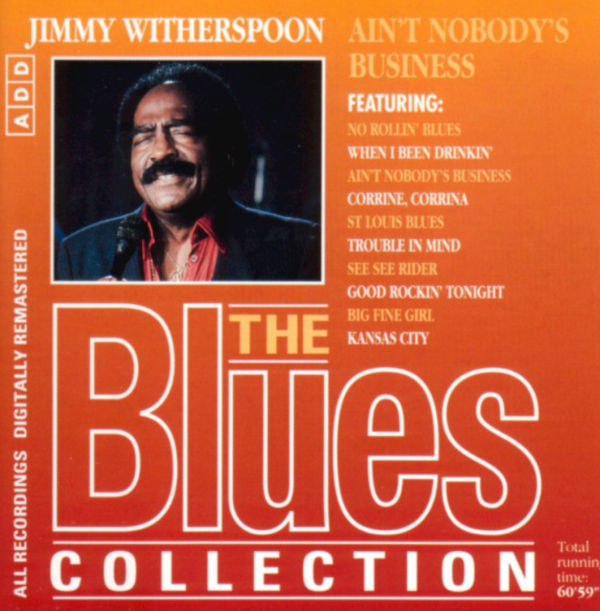
Jimmy Witherspoon is what’s called a jump blues singer. He was born in the 1920s and became well known in the Second World War years. He first came to the public eye singing in of all places, Calcutta, India, not a place known for the blues. His style of singing the blues by shouting out the lyrics is reminding me of Muddy Waters. His dad was a railroad worker who nonetheless sang in churches. His mom was a piano player. Clearly he had good musical genes. He was born in Arkansas, a great place to learn the blues. He’s performed with the likes of Dizzy Gillespie, Ben Webster, and Coleman Hawkins. The name of this album, “Ain’t nobody’s business”, is from his hit song in 1949, a simpler time when the world was recovering from the trauma of the Second World War.
Needless to say, this is not an audiophile recording. It’s got a kind of raw energy. Most songs are performed live in front of a clearly raucous audience who are not shy about joining in and screaming out their appreciation. Yes, it’s far removed from a classical concert where one doesn’t move a muscle till the orchestra finishes playing a piece. Here you are free to bellow out as the song is being played. I like that a lot. It’s a sense of energy that gives the blues a sense of authenticity. Blues and jazz is about American as it gets in music. It’s deep rooted in our culture. I got to appreciate the blues late in life but I’m glad I did.

Last edited:
We are listening to a New Orleans blues pianist James Booker whose life is so remarkable that it seems like a legend. Born in New Orleans in 1939 to a Baptist minister, he was a child prodigy who played the piano effortlessly from the age of six. He was classically trained in the music of Bach and could play the intricate fugues and counterpoint in Bach’s music like a knife cuts through butter. He was also gifted enough to play the trumpet and saxophone, but piano was his thing. He sadly was struck by an ambulance at the age of 9 traveling at high speed due to which his leg fractured in many places and had to be operated on. Didn’t seem to slow this wunderkind down one tad. He played the organ at his dad’s church. His dad and grandad were both pianists, so he had good genes.
By 11 he was performing on a New Orleans radio station. He kept up his classical music training and became fluent in the music of Rachmaninov and Chopin, major pianistic composers of classical music. He cut his first record in 1954 at 14 called “Doin the Hambone”. Artur Rubinstein was a great classical pianist who performed in New Orleans. He was introduced to James Booker who played for the distinguished pianist who was floored, saying he could never play at that tempo. In 1960, his song Gonzo reached no. 43 on the Billboard charts. His last recording was made in the 1980s.
His music sounds like a bluesy jazz pianist who sings every piece, kind of like Louis Armstrong. He doesn’t strike me as a blues genius like Muddy Waters. Maybe his deep classical training made him less of a blues diehard. But an amazing character. His voice is, well, an acquired. taste. He kind of croaks through the lyrics.
Recording quality is pretty mediocre but we’re talking about the blues, a genre not known for making great audiophile records. But it’s a slice of authentic Americana.
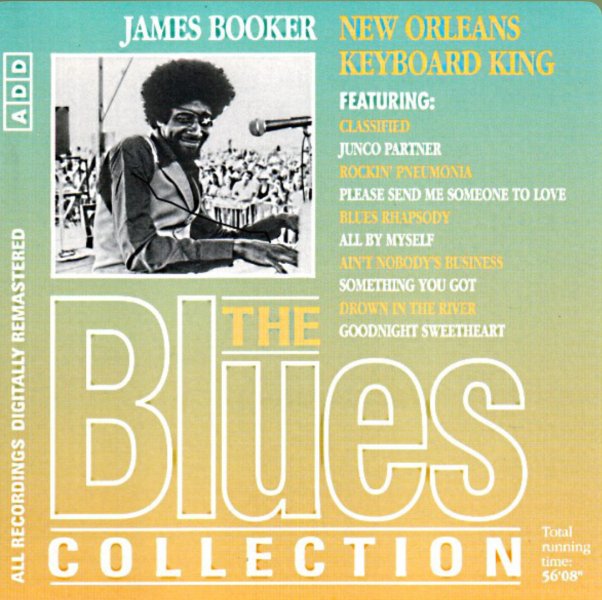
By 11 he was performing on a New Orleans radio station. He kept up his classical music training and became fluent in the music of Rachmaninov and Chopin, major pianistic composers of classical music. He cut his first record in 1954 at 14 called “Doin the Hambone”. Artur Rubinstein was a great classical pianist who performed in New Orleans. He was introduced to James Booker who played for the distinguished pianist who was floored, saying he could never play at that tempo. In 1960, his song Gonzo reached no. 43 on the Billboard charts. His last recording was made in the 1980s.
His music sounds like a bluesy jazz pianist who sings every piece, kind of like Louis Armstrong. He doesn’t strike me as a blues genius like Muddy Waters. Maybe his deep classical training made him less of a blues diehard. But an amazing character. His voice is, well, an acquired. taste. He kind of croaks through the lyrics.
Recording quality is pretty mediocre but we’re talking about the blues, a genre not known for making great audiophile records. But it’s a slice of authentic Americana.

Last edited:
What an amazing journey of history, music and personal narrative! I will be picking up some of this music! Thank you!Continuing our time travel adventure, we are now in France in the reign of King Louis XIII, who lived from 1601-1643. If you have visited Paris, you must have toured the famous Louvre Museum, the world’s most famous museum. Well, 400 years ago, this magnificent structure was the official residence of French kings. Not they didn’t have other palaces, like the Versailles. But in ooh la la Pari, they hung out at the Louvre. And every evening it was a place of dance, of music and gaiety. This wonderful recording gives us a taste of what musical life was in Paris 400 years ago for the ultra privileged who could attend the musical soirées of King Louis XIII. It’s a stark contrast to the Gothic era album by David Munro above. In the 12th century, they didn’t quite figure out how to make a tune. In the 16th century, they’d definitely made progress. No, it’s not Taylor Swift yet, but their music has a definite melodic rhythm, and they were getting the hang of it. Imagine if they could time travel and hear a Taylor Swift Eras concert. Then they could time travel back to tell Louis XIII all about this strange music from the 21st century.
This is a high-resolution recording from the legendary Harmonia Mundi label. I’m listening to my secondary system, all solid state, so I do miss the tube richness of my ARC and Lampi gear. But on this music, a bright sheen is probably what these guys were into. This is called the galant period in French history, when they’d figured out how to have a good time. The horrors of the French Revolution and the guillotine were still in the future.
Next time you visit the Louvre to see the famous Mona Lisa painting, which draws so many millions of tourists each year the French government decided to house it in its own gallery, imagine it as a place of music. Leonardo da Vinci who painted the Mona Lisa dragged the painting everywhere he went for decades. It’s a small painting. He would add a flourish, a dab here and there. And then put it aside. Now it’s the world’s most valuable painting, worth billions. A small painting, a few dabs of paint, centuries old, and the world’s most famous enigmatic smile. Worth billions. Makes you wonder….if time travel allowed to you visit da Vinci while he was painting it.
View attachment 144817
Today we are listening to a new opera recording by the San Francisco Symphony Orchestra that just won a Grammy Award a week ago. Score one for my hometown orchestra. It’s by Finnish composer Kaija Saariaho and it’s called Adriana Mater. Its libretto is in French because it was commissioned by the French National Opera and performed first at the Opera Bastille. This is a high-resolution 24-bit 192khz release available on all streaming channels. The story is about a modern day war fought in Europe — unnamed conflict — and its terrible impact on civilians caught up in it, especially women who are often subjected to terrible abuse. War brings out the worst in humanity. It’s pointless and yet humans seem incapable of resolving their differences peacefully and resort to mindless force with its tragic consequences.
Opera is the hardest genre in classical music to grok. You either love it or hate it, and far more fall into the latter category. An opera is drama set to music as in this case. It’s not pure entertainment. Its themes are often about tragedy, whether it’s the icy princess Turandot who chooses to chop off the heads of suitors unable to answer correctly three riddles — Puccini’s famous last unfinished opera Turandot -- or Verdi’s Otello based on Shakespeare’ tragedy about love and betrayal. You can’t listen to opera as you would a symphony or a piano sonata. There’s usually the language barrier. You have to let the music wash over you on a first listen. Since this is my first time listening to this opera, I won’t pass musical judgement— it’s remarkable that gifted composers are tackling opera still. I’d hate for to it to die as an artistic endeavor. It would be as tragic as if people stopped writing poetry. Like poetry, opera enriches the musical soul.
The lead character is a woman named Adrianna who suffers the abuse common to women in war zones and its terrible consequences. The music is dramatic and powerful, as it's portraying war and its impact on people. There’s a powerful choral accompaniment. Needless to say, opera is the hardest type of music to reproduce on a high fidelity system given its wide dynamic range. You have hundreds of instruments in the orchestra and a massive chorus singing. Having been to many live opera performances in exotic places, from Covent Garden in London where I hear Turandot live to the Metropolitan Opera in NYC where I saw Verdi’s Aida live with elephants on the stage, opera is best experienced live.
Sarriaho's music is a mix of modern classical atonal sounds with lyrical interludes that remind me of Puccini and Verdi. If you haven’t heard opera, I am not sure I’d recommend starting here. You might want to start with something more melodious like Bizet’s Carmen with its bouncy gypsy tunes. But you should learn to dig opera as much as you should learn to appreciate fine poetry.
I taught for 15 years in a small New England college town known for its famous writers and poets. Emily Dickinson and Robert Frost both lived there and wrote their most famous poems. Dickinson wrote these famous lines. Only poetry can express such feelings and thoughts. Similarly only opera can capture the horrors of war through music.
Because I could not stop for Death—
He kindly stopped for me—
The Carriage held but just Ourselves—
And Immortality.

Opera is the hardest genre in classical music to grok. You either love it or hate it, and far more fall into the latter category. An opera is drama set to music as in this case. It’s not pure entertainment. Its themes are often about tragedy, whether it’s the icy princess Turandot who chooses to chop off the heads of suitors unable to answer correctly three riddles — Puccini’s famous last unfinished opera Turandot -- or Verdi’s Otello based on Shakespeare’ tragedy about love and betrayal. You can’t listen to opera as you would a symphony or a piano sonata. There’s usually the language barrier. You have to let the music wash over you on a first listen. Since this is my first time listening to this opera, I won’t pass musical judgement— it’s remarkable that gifted composers are tackling opera still. I’d hate for to it to die as an artistic endeavor. It would be as tragic as if people stopped writing poetry. Like poetry, opera enriches the musical soul.
The lead character is a woman named Adrianna who suffers the abuse common to women in war zones and its terrible consequences. The music is dramatic and powerful, as it's portraying war and its impact on people. There’s a powerful choral accompaniment. Needless to say, opera is the hardest type of music to reproduce on a high fidelity system given its wide dynamic range. You have hundreds of instruments in the orchestra and a massive chorus singing. Having been to many live opera performances in exotic places, from Covent Garden in London where I hear Turandot live to the Metropolitan Opera in NYC where I saw Verdi’s Aida live with elephants on the stage, opera is best experienced live.
Sarriaho's music is a mix of modern classical atonal sounds with lyrical interludes that remind me of Puccini and Verdi. If you haven’t heard opera, I am not sure I’d recommend starting here. You might want to start with something more melodious like Bizet’s Carmen with its bouncy gypsy tunes. But you should learn to dig opera as much as you should learn to appreciate fine poetry.
I taught for 15 years in a small New England college town known for its famous writers and poets. Emily Dickinson and Robert Frost both lived there and wrote their most famous poems. Dickinson wrote these famous lines. Only poetry can express such feelings and thoughts. Similarly only opera can capture the horrors of war through music.
Because I could not stop for Death—
He kindly stopped for me—
The Carriage held but just Ourselves—
And Immortality.

Last edited:
Maurice Durufle’ was a consummate French composer who lived from 1902-86. He was the model French composer: literate, scholarly, not given to overt bombastic music, and fiercely self-critical. His magnificent Requiem composed in 1947 is one of his masterpieces.
We are listening to a lovely Harmonia Mundi recording made in DSD in Magdalen College, one of Oxford’s most distinguished colleges. Magdalen College was founded in 1458 by William Waynflete, Bishop of Winchester, and Lord Chancellor. Ten Nobel Laureates have taught here, as have Kings, Prime Ministers, and great writers including C.S. Lewis, a close acquaintance of Tolkien who wrote the Lord of the Rings at Oxford. Both were on faculty in the English department.
Walking through the grounds of Oxford is like walking back in time. Classes have been held continuously at Oxford for almost a thousand years as it was founded in 1096. Radcliffe Square in Oxford is the greatest university courtyard in the world. Sitting in its presence is like being visited by divinity. You sense the centuries of scholars and thinkers who have roamed its grounds, from Tolkien as he wrote Lord of the Rings to Lewis Carroll who wrote Alice in Wonderland to the many renowned scientists who worked here. It was always renowned as a religious school. You went to Oxford to become a priest in its original mission. That hasn’t changed in modern times in the sense that every college at Oxford has a glorious chapel with fabulous choirs who sing many times during the week. It’s a paradise for lovers of choral music.
Bill Ives leads the Choir of Magdalen College in an inspiring performance of Durufle’s Requiem. The greatest composers have written Requiems. Mozart never finished his, and as the final scenes of the movie Amadeus hinted, Salieri tried to steal Mozart’s score on his deathbed (probably a fictional story). Verdi wrote a bombastic Requiem that sounds like one of his operas. Durufle’s Requiem is the polar opposite. It is cerebral but full of haunting melodies and captivating choral passages.
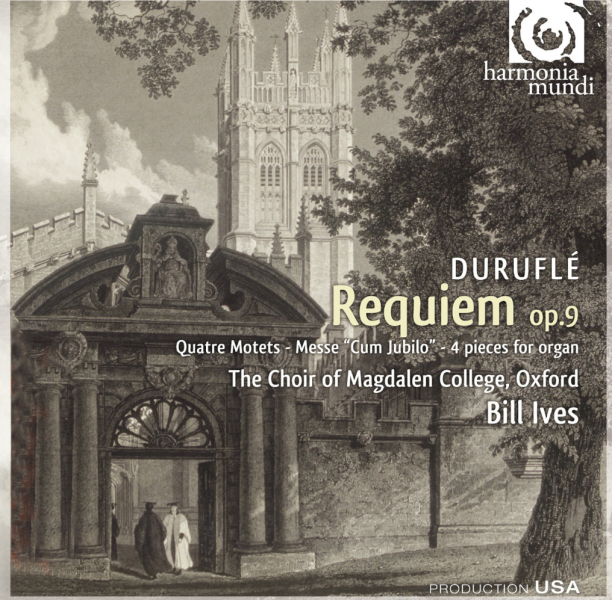
We are listening to a lovely Harmonia Mundi recording made in DSD in Magdalen College, one of Oxford’s most distinguished colleges. Magdalen College was founded in 1458 by William Waynflete, Bishop of Winchester, and Lord Chancellor. Ten Nobel Laureates have taught here, as have Kings, Prime Ministers, and great writers including C.S. Lewis, a close acquaintance of Tolkien who wrote the Lord of the Rings at Oxford. Both were on faculty in the English department.
Walking through the grounds of Oxford is like walking back in time. Classes have been held continuously at Oxford for almost a thousand years as it was founded in 1096. Radcliffe Square in Oxford is the greatest university courtyard in the world. Sitting in its presence is like being visited by divinity. You sense the centuries of scholars and thinkers who have roamed its grounds, from Tolkien as he wrote Lord of the Rings to Lewis Carroll who wrote Alice in Wonderland to the many renowned scientists who worked here. It was always renowned as a religious school. You went to Oxford to become a priest in its original mission. That hasn’t changed in modern times in the sense that every college at Oxford has a glorious chapel with fabulous choirs who sing many times during the week. It’s a paradise for lovers of choral music.
Bill Ives leads the Choir of Magdalen College in an inspiring performance of Durufle’s Requiem. The greatest composers have written Requiems. Mozart never finished his, and as the final scenes of the movie Amadeus hinted, Salieri tried to steal Mozart’s score on his deathbed (probably a fictional story). Verdi wrote a bombastic Requiem that sounds like one of his operas. Durufle’s Requiem is the polar opposite. It is cerebral but full of haunting melodies and captivating choral passages.

Last edited:
Oxford’s academic rival has always been University of Cambridge, the two representing the Crown Jewels of Great Britain. The worth of these universities is incalculable. Isaac Newton was the Lucasian Professor of Mathematics at Cambridge. Without Newton’s laws or his invention of calculus, the world’s economies would grind to a halt in a millisecond. Darwin studied here as a student, hoping to become a priest. He became instead the greatest biologist in history with his discovery of evolution by natural selection. The DNA double helix structure was discovered here by Crick and Watson opening the door to countless innovations in medicine. Alan Turing who invented the modern computer, also called Turing’s machine, taught at Cambridge. He also saved western civilization by cracking the Enigma code in the Second World War.
We are listening to Choir of King’s College, Cambridge, in a magnificent performance of choral music beginning with Claudio Monteverdi’s scintillating Cantate Domino. King’s College choir was founded, appropriately enough, by the 19-year-old King Henry VI in 1441. It has remained a bastion of religious scholarship and worship for almost 600 years. That history shows in this brilliant 24-bit 96khz recording featuring the angelic voices of its boys choir. According to the King’s decree, the choir was supposed to include six “singing boys” and 16 choristers who were “poor boys of a strong constitution and a honest conversation”. I love the way Kings wrote such decrees 600 years ago!
Today, the choristers are selected from the 420 students at King’s College School, across the river from King’s College, now featuring 420 girls and boys. The men in the choir are of course required to be undergraduate students at the University of Cambridge. You have to be brilliant and have a great singing voice to be in this choir. It must be daunting to sing in a chapel that’s 600 years old. Having seen it in person, I can attest to its architectural magnificence. There’s nothing like it in the US.
This recording will teach you a lot about midrange coloration in your system. It should sound entirely natural with not a hint of midrange brightness, even as the high treble of the young boys voices soars in the chapel. A desert island disc.
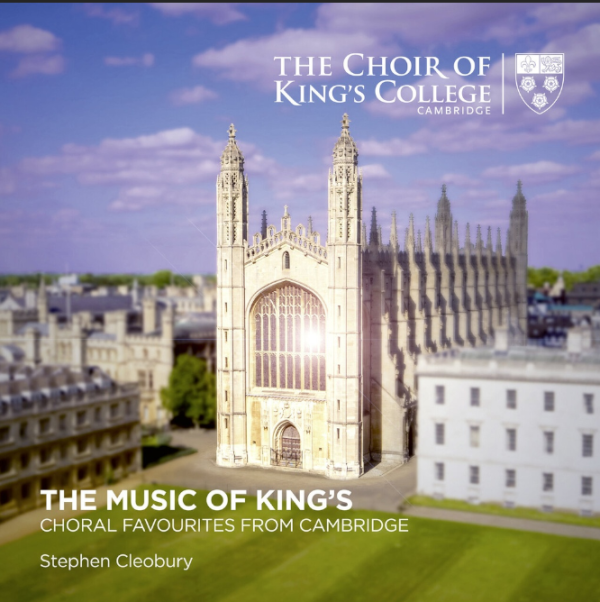
We are listening to Choir of King’s College, Cambridge, in a magnificent performance of choral music beginning with Claudio Monteverdi’s scintillating Cantate Domino. King’s College choir was founded, appropriately enough, by the 19-year-old King Henry VI in 1441. It has remained a bastion of religious scholarship and worship for almost 600 years. That history shows in this brilliant 24-bit 96khz recording featuring the angelic voices of its boys choir. According to the King’s decree, the choir was supposed to include six “singing boys” and 16 choristers who were “poor boys of a strong constitution and a honest conversation”. I love the way Kings wrote such decrees 600 years ago!
Today, the choristers are selected from the 420 students at King’s College School, across the river from King’s College, now featuring 420 girls and boys. The men in the choir are of course required to be undergraduate students at the University of Cambridge. You have to be brilliant and have a great singing voice to be in this choir. It must be daunting to sing in a chapel that’s 600 years old. Having seen it in person, I can attest to its architectural magnificence. There’s nothing like it in the US.
This recording will teach you a lot about midrange coloration in your system. It should sound entirely natural with not a hint of midrange brightness, even as the high treble of the young boys voices soars in the chapel. A desert island disc.

I took this picture of Radcliffe Square in Oxford in November 2019 during a visit to give an invited lecture at University College, London. It’s much prettier in person. Warning: when visiting either Cambridge or Oxford, do not walk on the grass. That’s strictly forbidden. Centuries of past Kings and Prime Ministers would glare at you. It’s local custom. Don’t ask why!


Listening to Sibelius’ wonderful Symphony No. 3 with the Berlin Philharmonic under Simon Rattle. It’s a majestic symphony that starts with a brooding theme for double bass that keeps repeating throughout. The recording seems a bit compressed, which is my experience with most high resolution recordings. They seem to lack the dynamics of great analog recordings on vinyl. I don’t know if it’s Roon compressing the dynamics or the original recording was mixed to keep the dynamic range limited. But it’s a great performance by one of the world’s great orchestras under a famous conductor. Sibelius’ music is spellbinding as always.
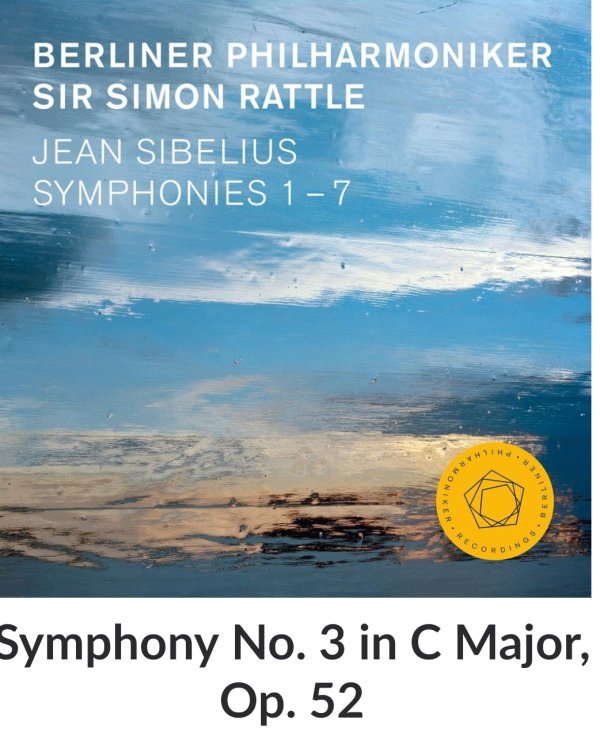

Similar threads
- Replies
- 63
- Views
- 5K
- Replies
- 118
- Views
- 72K
| Steve Williams Site Founder | Site Owner | Administrator | Ron Resnick Site Owner | Administrator | Julian (The Fixer) Website Build | Marketing Managersing |














